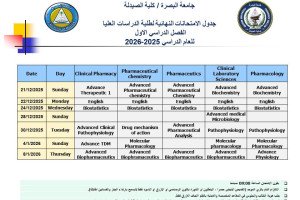
The College of Pharmacy at the University of Basrah organized a panel discussion entitled (The Epidemic of Crimean-Congo Hemorrhagic Fever in Iraq), with the participation of researchers and specialists.
The discussion session included a lecture given by Prof. Dr. Abdul-Ilah Abdul-Hussein Saheen, in which he discussed the history of Crimean-Congo hemorrhagic fever and comparing it with the rest of the hemorrhagic fever of different viruses. The history of the disease began in the Ukrainian Crimean island in 1944, followed by it in Congo in 1969. It was also endemic to the Middle East, including Iraq, where the first infection appearedthe end of the seventies of the last century and its symptoms are headache and pain in the muscles and joints. The disease may progress to damage to blood vessels, resulting in bleeding from the mucous membranes, bruising under the skin, enlargement of the liver, and kidney failure may occur.
As for the death rate, it ranges between 10-40% of the number of severe cases admitted to the hospital, while there are 85% of the cases being subclinical. This fever is also characterized by the fact that its intermediate host is transmitted between ticks and livestock such as goats, sheep and cows. There is no special vaccine for the disease, and there is no specialized treatment for the virus, but rather adjuvant treatments to prevent the development of infection.
The most dangerous people are livestock breeders, where infection occurs either due to a tick bite or contact with the meat of infected animals. Therefore, it is necessary to buy meat from health-approved butcher shops, as well as extreme caution when using meat inside the house, such as wearing gloves sterilizing utensils and knives with diluted domestic alcohol, and cooking meat well for the purpose of virus eradication








